Matched Betting Liquidity
Andrea
25 Jun 2020
Updated: 12 Jun 2023
What is Liquidity in Matched Betting? An Overview
In Matched Betting liquidity is the maximum about of money that you can stake on a lay bet at a betting exchange. It is displayed underneath the lay odds at a betting exchange and can constantly change.
In this example from Smarkets Betting Exchange you can see the liquidity is £700.

Anytime you are Matched Betting it is always useful to consider the amount of liquidity that is available at the exchange.
Ideally, the liquidity available on the lay odds at a betting exchange must be at least the same or higher than the lay stake you want to use for your Qualifying or Free Bet.
If the liquidity available is greater than your lay stake your lay bet will immediately get fully matched (taken) at the exchange.
If the liquidity available is less than your lay stake your lay bet will not get matched (taken by the exchange) or only get partially matched (i.e. only part of your total lay stake will get taken by the exchange). If this happens to you, you don’t need to panic; instead you just need to follow our guide on how to fix partially matched and unmatched bets.
Betting exchange liquidity tends to be lower when a game or race is still some time away from starting and/or when a game, race, or specific betting market, is not very popular to bet or trade on. In football, Goalscorer markets tend to have much lower liquidity than popular markets such as the 90-minute winner market or both teams to score market.
To avoid low liquidity when placing matched bets we recommend to only bet on popular sporting events, such as Premier League Football and on popular betting markets.
For horse racing we also recommend placing your bets on the day of the race - not before, otherwise there will hardly be any liquidity available. We’d also advise you to avoid placing your bets in the hour before the start of a race as at this time both lay odds and liquidity can change rapidly, making it difficult for us to place our lay bets successfully.
On our Oddsmatching Tool, the liquidity available at the betting exchange of the bet you are considering to do is shown in the column named ‘Available’.

Liquidity available at the betting exchange is also shown in our Oddsmatching Tool pop up Matched Betting calculator so that you can clearly see if there is enough liquidity available before you place your bets...
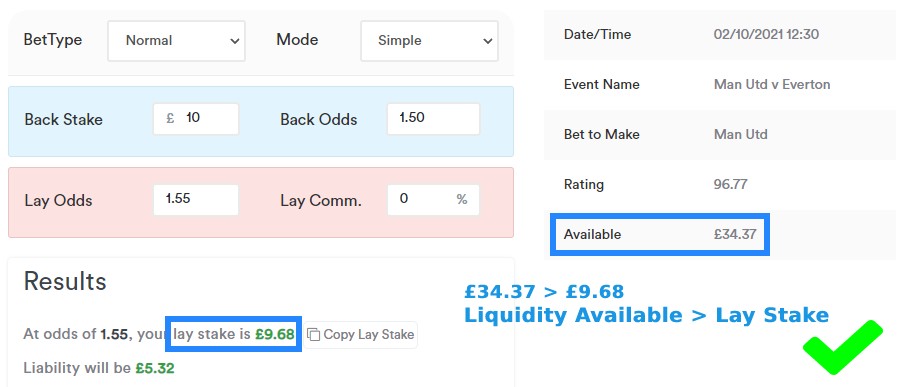
...or if there's not enough available.
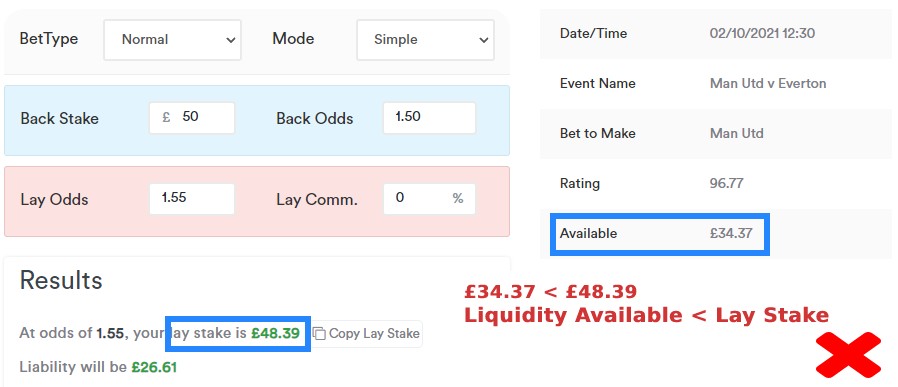
A warning will actually pop up below the calculator informing you if the liquidity is low:

(The above examples are using 0% commission at Smarkets Betting Exchange. This offer is frequently available to our Platinum and Diamond Members and really helps boost your profits with Matched Betting.)
The ability to see the amount of liquidity available is also extremely useful when you are using the exchange integration feature on our Oddsmatching Tool to place your matched bets as well. If you're not using the integration feature on the Oddsmatcher yet we highly recommend it as it can help save you time when Matched Betting.
What is liquidity in Matched Betting? A full guide.
For those interested in fully understanding exactly what Matched Betting liquidity is we first need to consider what betting exchanges are and how betting exchange liquidity works.
What is a betting exchange?
In our free trial we have a great video guide that explains what betting exchanges are, how they work and how we use them in Matched Betting to cover our bets at the bookmakers.

Put simply though, betting exchanges are a special kind of betting website that enable random people to bet with each other.
Normally you’d never bet with a complete stranger as you could never trust that they’d pay you your winnings if you won.
A betting exchange completely removes this concern as they take on the responsibility of holding everyone’s money for them once bets are placed and then paying out winners once bets are settled. Safe money exchange (or transfer) between bettors is actually the service betting exchanges charge a commission fee for.
Considering this at a finer level relevant to Matched Betting, what the betting exchange is actually doing is safely transferring money, in the form of winnings, between back bettors on the exchange (those betting that an outcome will happen) and lay bettors on the exchange (those betting that an outcome won’t happen). As we are Matched Betting we tend to also be lay bettors at an exchange.
Betting exchange liquidity
If we look at an example from Betfair Betting Exchange on a Premier League game between Tottenham and West Ham we can see the back bet odds (in blue) and lay bet odds (in pink) for each outcome in the game, as well as the available liquidity on all bet options.
(If we were using Smarkets Betting Exchange in this example, the back bet odds would be in green and the lay bet odds in dark blue).
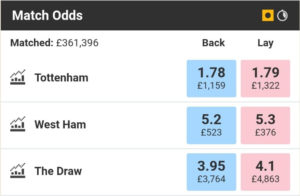
Where do the liquidity amounts come from though?
Why do the liquidity amounts also constantly change?
What does the liquidity have to be for Matched Betting?
Why and how does the available liquidity vary between games, races and betting markets?
Why is it important to consider this variation in available liquidity when Matched Betting?
In this article we’re going to answer all these questions starting with a closer look at the exchange odds for Tottenham winning vs West Ham.

Liquidity of the lay odds
The back odds (in blue) for Tottenham have £1,159 of liquidity available, and the lay odds (in pink) against Tottenham have £1,322 of liquidity available (at the time the screenshot was taken!).
As we are Matched Betting we are only ever interested in the lay odds at the betting exchange so in this explanation we are only going to focus on the liquidity of the lay odds. Once you understand the liquidity of the lay odds though it’s possible to apply the same concept to the liquidity of the back odds too as they both work in the same way.
Where does the liquidity come from?
The available liquidity on the lay odds (£1,322) comes from a group of back bettors, who want to bet on Tottenham winning at odds of 1.79 at the betting exchange. Each of the back bettors in the group has stated a stake amount that they want to bet on Tottenham with at these odds. As an example, one in the group might want to bet £2 on Tottenham to win, another £20, a third £100, a forth £200 and the fifth £1000.
The entire group’s bet stakes combined add up to £1,322 – the total available liquidity of the lay odds.
Does the total available liquidity of the lay odds change?
Yes – all the time.
At any point another back bettor might join the group and also say they want to bet on Tottenham to win at odds of 1.79, and that they want to bet £100. If this happened the liquidity available (or total staked by the entire back bettor group) would increase to £1,422.
Alternatively, one back bettor in the group may also change their mind and cancel their bet. This would cause the liquidity (or total staked by the entire back bettor group) to drop by whatever that bettor’s stake was.
New back bettors who are wanting to bet and/or existing back bettors cancelling their bets, are the first reason why the liquidity of the lay odds can constantly change on the exchange
There can be hundreds of back bettors constantly adding or cancelling their bets on an outcome (such as Tottenham to win) at any one time. This means the liquidity available then constantly changes.
What else can cause the amount of liquidity available to change?
Once they have announced their stakes all the back bettors have to do is wait to see if a lay bettor, or even several lay bettors, will agree to take their back bets on at these 1.79 odds.
This is where we come in now! As we are matched bettors we are also considered to be lay bettors at a betting exchange (at least in the vast majority of cases).
Following our matched bet calc, if we go to place a lay bet of £19.85 at the exchange against Tottenham winning, what will happen?
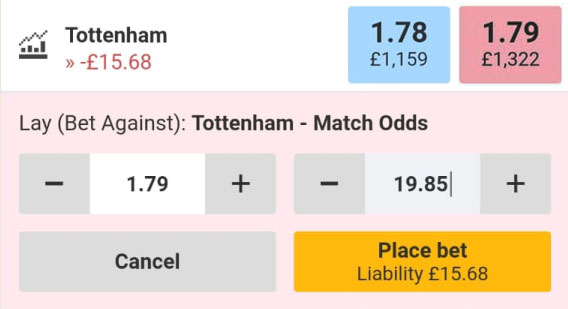
As soon as we place our lay bet, the exchange will take our requested £19.85 stake amount from the group of back bettors (not from us!) and hold this money until the Tottenham vs West Ham game ends, all bets are settled and winners have to be paid out.
The exchange takes the requested lay stake from the back bettor group on a first come first serve basis. So, basically whichever back bettor put their bet stake amount up first in the back bettor group at the odds of 1.79 – their stake will get taken first.
The stake we request with our lay bet will rarely (if ever) happen to be an exact match with the amount put up by the first back bettor in the group. If our lay stake is less than what the first back bettor’s back stake is then the exchange will just take £19.85 from the back bettor's total stake. The back bettor will then wait for another lay bettor (or matched bettor) to come and request the remaining amount of their stake.
If our lay stake is more than what the first back bettor’s stake is then the exchange will take all of the first back bettors stake, plus some (or all) of the 2nd back bettors stake, the 3rd back bettors stake and so on as required until it reaches our full requested lay stake amount of £19.85. For our single lay stake request of £19.85 the betting exchange could be holding the money from one single back bettor or several.
We of course will never know though as we don’t see any of this going on!
All we see is one number – the liquidity – which is the combined stakes of all the back bettors.
As soon as our lay bet is successfully placed the liquidity on the lay odds will go down instantly by the amount of our lay stake. In our Tottenham example it would go from £1,322 to £1,302.
(Our balance at the exchange however would go down by the liability of our lay stake. Read “What is liability in Matched Betting” if you'd like a better understanding of this).
Lay bettors placing bets is the second reason why the liquidity of the lay odds can constantly change on the exchange
Lots of lay bettors (or matched bettors) can be placing lay bets at the same time and this can cause the available liquidity to drop. Lay bettors requesting large stakes of hundreds or thousands of pounds can cause available liquidity to drop massively very suddenly.
If there are no stakes available from back bettors then we can’t place a lay bet
Now we’ve understood what’s happening behind the scenes when we place a lay bet at the exchange, where the liquidity comes from and why the liquidity can constantly change it may have also dawned on you why low liquidity on lay odds can be an issue in Matched Betting when trying to place a lay bet.
Our lay bets can only happen when there is money available from back bettors for the exchange to take.
We can request a lay stake at the lay odds we want all day long, but if there are no back bettors putting money forward at those odds then our lay bet can’t be taken.
What does it look like on Betfair Betting Exchange when there is no available liquidity on the lay odds on an event outcome? A pink blank box!

On Smarkets Betting Exchange you’ll see a blue box with the word ‘Ask’ in it:

This makes sense as if we want we can put our lay stake in at the lay odds we want and 'Ask' if there are any back bettors on the exchange interested in putting a stake on the bet.
If you are trying to bet on an event that isn’t very popular or is happening in a couple of days time you will see lots of these blank boxes (especially for horse racing). Here’s an example for an upcoming greyhound race where some of the runners have no liquidity available on their lay odds.
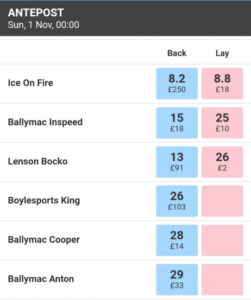
What happens if there is some liquidity available though?
Here we can see some lay odds which have an available liquidity of just £10.

If we tried to place a lay bet with a £19.85 stake on these odds, what would happen?
The exchange can’t take our full requested lay stake as the money from the back bettors just isn’t there.
The exchange takes what it can though from the back bettors – which in this case would be £10.
Only £10 of our lay bet would then be matched and £9.85 would be left unmatched.
In Matched Betting unmatched bets or partially unmatched bets at the exchange like this are an issue as they mean that we haven’t equally covered all outcomes of the event - which could end up costing us.
Although we can fix this issue following our unmatched and partially matched bets guide, we are best to avoid this issue happening altogether by not placing bets on outcomes that have no or low liquidity at the exchange.
How do we decide whether the liquidity at the exchange is low or not?
In Matched Betting liquidity is said to be low when it is less than the lay stake amount you want to use:
Lay stake = £19.85
Liquidity = £15.00
It is considered OK when it is the same or slightly more than your lay stake:
Lay stake = £19.85
Liquidity = £20.00
Then good when it is more, or substantially more, than your lay stake:
Lay stake = £19.85
Liquidity = £100.00+
We advise beginners to always choose bets on the Oddsmatching Tool that have good liquidity available. We advise this as it greatly reduces the chances of your lay bet being unmatched or partially matched at the betting exchange.
When does low liquidity occur at the betting exchange?
When low liquidity occurs at the betting exchange can vary between sports.
Football:
In football liquidity tends to be lower in little known leagues or obscure leagues. This is one reason why we recommend beginners to only choose well known popular football leagues to bet on when Matched Betting.
Then in the popular leagues, such as the Premier League, the liquidity can be quite low 4-5 days before a game.
2-3 days before a game the liquidity will then start to increase, then on match day it will get really high, often up to £4000 or more in some cases.
It is rare that you have to worry about liquidity when betting on any game in the Premier League – unless you are looking at betting on an unpopular market, such as the Last Goalscorer market. The match winner market, correct score market, half-time markets, both teams to score market and over/under total goals markets always tend to have very good liquidity available as they are popular betting and trading markets on the exchanges.
Horse Racing:
Liquidity on horse racing doesn’t tend to be good until the actual day of the race. It also tends to increase closer to the start of the race. If you can only fit Matched Betting in first thing on a morning and are looking at betting on horses we’d advise to watch out for low liquidity.
This is less of an issue on Saturdays and during big horse racing events such as Cheltenham and Royal Ascot though.
We advise avoiding betting the hour just before a race is due to start as at this time both lay odds and liquidity can change rapidly and make it difficult for us to place our lay bets successfully at the odds we want.
Horse racing doesn’t have the kind of markets that football has available and both the win and place markets both tend to have good liquidity overall.
How can you avoid low liquidity in Matched Betting?
We’ve got some awesome tools that help you avoid Matched Betting when liquidity is low at the betting exchanges.
The Oddsmatcher Tool lists the available liquidity for every matched bet it finds. You can also tell the Oddsmatcher Tool to avoid finding bets that have a liquidity lower than a specific amount (e.g. £50).

The pop up calculators in the Oddsmatcher Tool then also show you the available liquidity of a bet, and also warn you when the liquidity at the exchange is lower than your lay stake worked out by the calculator.

For Matched Betting beginners, the pre-set signup offer filters on the Oddsmatching software are also set up so that you are automatically not shown bets which have a liquidity lower than what your lay stake amounts will likely be in most cases.
All these tools are only available to our Platinum Members, so if you want to get started Matched Betting and don't want to worry about liquidity at the betting exchange then we’d recommend upgrading to Platinum now.
That’s pretty much everything you ever need to know about Matched Betting liquidity!
We hope you enjoyed this article and share it with any friends who are Matched Betting and struggling to get to grips with what liquidity is.
Need a helping hand with Matched Betting?

Our Facebook Group, which currently has over 45,000 members, is a great place to ask for help and ask questions, especially if you are new to Matched Betting. Our community forum is also a great place to ask for help.
Alternatively you can also contact us directly for support too.
Interested in Getting Started Matched Betting?
You can start learning for free with our free trial and make your first profits.

Alternatively, upgrade to our Platinum Membership here.
It is possible to make the cost of a Platinum membership back within an hour or so once you get the hang of things. Talk about value for money!

